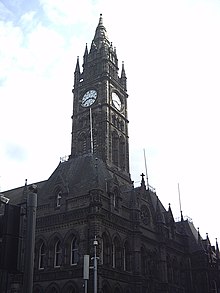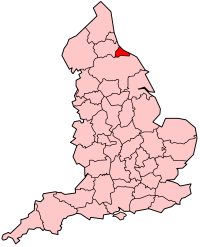Cleveland (county)
| Cleveland | |
|---|---|
 | |
 Flag
 Coat of arms
| |
 The former administrative county of Cleveland shown within England | |
| Area | |
| • 1974 | 144,085 acres (583.09 km2)[1] |
| Population | |
| • 1973 | 566,740[2] |
| • 1981 | 565,935 |
| • 1991 | 541,333 |
| History | |
| • Origin | County Borough of Teesside |
| • Created | 1974 |
| • Abolished | 1996 |
| ONS code | 14 |
| Government | Cleveland County Council |
| • HQ | Middlesbrough |
| Subdivisions | |
| • Type | Non-metropolitan districts |
| • Units |
|
 | |
Cleveland was a ceremonial county located in northern England. It was created in 1974 under the Local Government Act 1972, and named after the historic area of Cleveland, Yorkshire. The county was abolished in 1996.
NUTS statistical regions of the United Kingdom were also introduced in 1974. This caused South Humberside to be put with the reformed counties using the name Yorkshire, to form Yorkshire and Humber. South Tees came under North East of England region.[3]
Formation[]
A Bill as originally presented in November 1971 that intended the administrative county to have been an extended form of the then present county borough of Teesside , an independent district in the North Riding from 1968 to 1974. On 1 April 1974, by the Local Government Act 1972, most of the then Cleveland constituency and Hartlepool were incorporated as the Cleveland non-metropolitan county.[4]
Operation[]
The area was partitioned between the four boroughs of Hartlepool, Stockton-on-Tees, Middlesbrough and Langbaurgh-on-Tees, the latter of which took its name from the former Langbaurgh East. The county town was Middlesbrough. The administrative county bordered County Durham to the north and North Yorkshire to the south, and it faced the North Sea to the east. Cleveland had a total area of 225 square miles (583 km2).
Proposed abolition[]
Local government reorganisation, recommended by the Banham Review and accepted by the government, meant that each district borough be re-organised into separate unitary authorities with the Tees be re-established as a ceremonial border between North Yorkshire and County Durham.[5][6] The county district boroughs of Cleveland were re-organised into Hartlepool, Stockton-on-Tees, Middlesbrough and Redcar and Cleveland. The reorganisation meant that Stockton-on-Tees became the only local authority in England to be split between two counties.
This split was contested by Cleveland County Council, who applied for judicial review over the decision. According to the Minister, David Curry, in the Commons debate on the order on 11 January 1995, this caused a delay from 1 April 1995 as the reorganisation date to 1 April 1996.
Abolition[]
As the first of the Orders to be laid before Parliament, it was done in two stages. The Cleveland (Structural Change) Order 1995[7] had the main effect of abolishing the County Council, whilst the Cleveland (Further Provision) Order 1995[6] abolished the actual administrative county, creating four new (non-metropolitan) unitary authorities coterminous with each of the boroughs. A division was forced by the Opposition, on the first Order, with 310 in favour and 223 opposed. Of Cleveland's six MPs, Mo Mowlam and Frank Cook (both Labour) voted against, with Tim Devlin and Michael Bates (both Conservative) voted for. Stuart Bell and Peter Mandelson (both Labour) were present at the debate but did not vote.
Town twinning[]
Cleveland, as a conurbation of settlements, was twinned with:
See also[]
References[]
- ^ Local government in England and Wales: A Guide to the New System. London: HMSO. 1974. p. 37. ISBN 0-11-750847-0.
- ^ Registrar General's annual estimated figure mid 1973
- ^ Great Britain Historical GIS / University of Portsmouth, Teesside County Borough (historic map). Retrieved 17 September 2009.
- ^ Michael Bates, MP for Langbaurgh (17 June 1993). "Cleveland County Council (Abolition)". Parliamentary Debates (Hansard). United Kingdom: House of Commons. col. 1089–1098.
- ^ "Teesside: Town and country welcome Whitehall compromise". The Times. London: Thomson Corporation. 21 March 1972.
- ^ Jump up to: a b "The Cleveland (Further Provision) Order 1995", legislation.gov.uk, The National Archives, 10 July 1995, SI 1995/1747, retrieved 13 July 2021
- ^ "The Cleveland (Structural Change) Order 1995", legislation.gov.uk, The National Archives, 30 January 1995, SI 1995/187, retrieved 13 July 2021
- ^ "Interactive City Directory". Sister Cities International. Archived from the original on 5 October 2019. Retrieved 5 October 2019.
External links[]
- Cleveland, England
- Places in the Tees Valley
- History of County Durham
- History of the Borough of Hartlepool
- Metropolitan areas of England
- Counties of England established in 1974
- Counties of England disestablished in 1996


